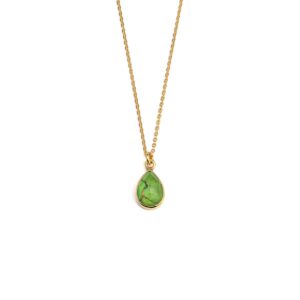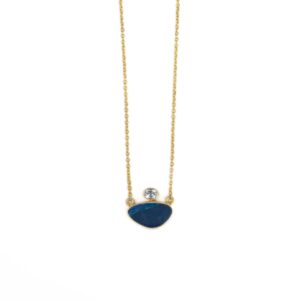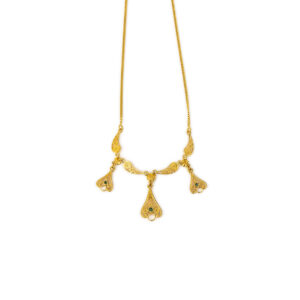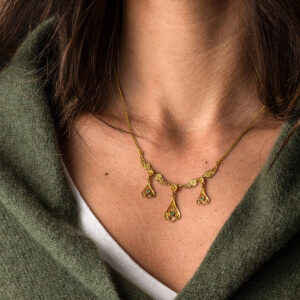Necklaces
Tear Drop Green Copper Necklace – 925 Sterling Silver and Gold Plated
Made of 925⁰ sterling silver and gold plated.
Handmade in Greece.
As in all handmade items, there may be small differences in weight and dimensions and this is what makes them unique and precious.
Explore Ionian Colors Collection
The collection contains jewelry with unique semi-precious stones in beautiful colors.
925 Sterling Silver and Gold Plated London Blue Topaz Necklace
Made of 925⁰ sterling silver and gold plated.
Handmade in Greece.
As in all handmade items, there may be small differences in weight and dimensions and this is what makes them unique and precious.
Explore Ionian Colors Collection
The collection contains jewelry with unique semi-precious stones in beautiful colors.
Opal and London Topaz Necklace – Sterling Silver and Gold Plated
A statement necklace with Opal and London Topaz stone.
Made in 925° sterling silver and gold plated
Handmade in Greece
As in all handmade items there may be small differences in weight, dimensions and this is what makes them unique and precious.
18K Gold Byzantine Filigree Emerald Necklace
1.386,00€Byzantine necklace is embellished with a fine filigree, three rosettes flowers and emeralds.
Handmade with the great attention to detail. Inspired by Byzantine art.
Made in 18k gold
Filigree is a delicate kind of jewellery metalwork, made with tiny beads or twisted threads, or both in combination, soldered together or to the surface of an object of the same metal and arranged in artistic motifs. The art of filigree dates back to ancient history. The first of the found jewelry in this technique have been found in Mesopotamia and dates to thousands of years BC. In the ancient world and particularly in Asia Minor, this art grew were at the highest level.
Rosette flower
The rosette (rose) is a timeless jewel, symbol and amulet. The origin of the term is the Greek word for rose – rodon (ρόδον). Its use began in the Mycenaean era and continues as far as the 2nd millennia BC. The Mycenaean Rosette is a motif that was widespread throughout Mesopotamia, Egypt, Greece and other ancient civilizations. It is inspired by a Mycenaean rosette bead, found at Mycenae, dated to 1400-1300 B.C. The rosette were used extensively in ancient Greek Mycenaean jewels, in architecture, pottery and in sculptures from 1500 BC. Mycenaean rosettes usually had 6 or 8 or 12 leaves, and sixteen leaves during the Macedonian Dynasty. Such details as the rodax shape and the number of leaves tend to vary with the era or beliefs. The rosettes were used to decorate the cloths, the belts and wreaths of the Kings. The number of leaves had a symbolic character each time. The four elements of nature (wind, earth, fire, water), the seven wonders of the ancient world or the twelve gods of ancient Greeks and the world domination and radiance of the Kings of Macedonia. They were signs of beauty, purity, eugenics, worship and power. Rosette or Rodax was probably the most popular and favorite decorative element in Mycenaean era, classical antiquity and Byzantine times.










